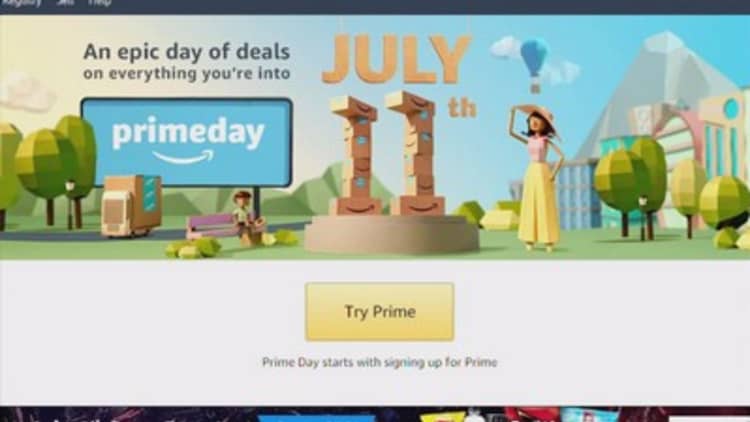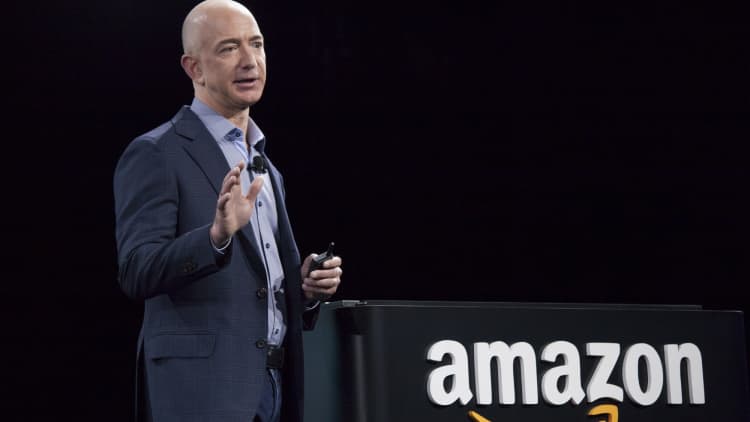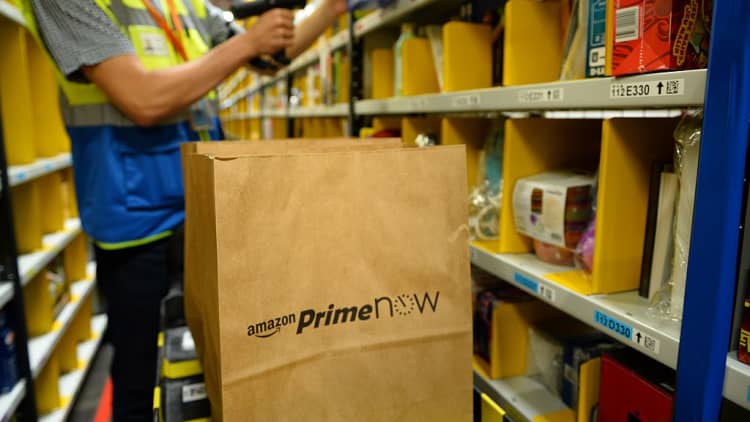
Amazon's third, annual Prime Day begins Monday evening, and shoppers are routinely buzzing about when and where to find the best deals.
But this year is different. With the Amazon-Whole Foods deal at the top of everyone's mind, the Seattle-based e-retailer this time could use Prime Day to showcase and sell something it hasn't been best known for in the past: groceries.
"Coming off the Whole Foods' press coverage, [Amazon] can leverage shoppers' interest in this deal," Kantar Retail's e-commerce analyst, Meaghan Werle, told CNBC.
On Prime Day, Amazon can try to get more people to sign up for AmazonFresh, order from Prime Pantry or try its meal kits, which compete with now-public Blue Apron, Werle said.
AmazonFresh is Amazon's take on a grocery delivery and pick-up service, available exclusively to Prime members in select cities across the U.S. and growing. Prime Pantry, an "everyday essentials" division of Amazon.com, features many products from one of Amazon's own private-label food brands, Wickedly Prime. Amazon-branded popcorn, anyone?
"I think [Amazon] will definitely focus a lot on food [this year], as it becomes more of a staple channel," Werle added.
One example of Amazon trying to push further into grocery: the company has said it plans to sell various food and household items for as much as 35 percent off with onsite coupons in Prime Pantry. This, in addition to all the special deals Prime members can shop from July 8 through July 11.
Amazon announced Friday that through Prime Now, its fastest delivery method, Prime members can shop exclusive deals — many for food and beverage items — available for free, two-hour delivery, ahead of the highly anticipated, 30-hour Prime Day.
Prime members in more than 30 U.S. cities will see discounts on grocery items like Halo Top ice cream, La Croix sparkling water, strawberries and even alcohol in select cities, starting on July 8.
Other discounts are being rolled out for Haagen-Dazs ice cream, Larabars protein snacks, Gatorade sports drinks and other fresh produce like raspberries and blueberries.

Amazon has declared July 11 to be Prime Day, but it's already evident the savings will kick off even earlier this year, what marks Amazon's third attempt at such an event.
The first Prime Day was held on July 15, 2015, as a way to mark Amazon's 20th anniversary, and it proved to be such a success boosting sales and bringing in new Prime members that the company did it all again on July 12, 2016.
With an Amazon-Whole Foods deal in the works, though, online shoppers might have their eyes set on supermarket staples this July in place of electronics, which have notably been best-sellers for the internet giant in past Prime Days.
"It's no secret that some of Prime Day's best deals have been on Amazon products – Audible, Kindle or even Prime Memberships," Maya Mikhailov, co-founder of GPShopper, told CNBC.
Yet, considering how this year Amazon is using Prime Day to introduce customers to the company's newest grocery offerings, and with more than 85 million Prime members, traditional grocery retailers should be "very worried" this time around, Mikhailov said.
Kantar Retail's Werle also said she'll be watching next week to see how Amazon leverages the visibility of its private-label brands, especially in the fashion department.
"Amazon seriously hopes to conquer the fashion and apparel market," a new report from One Click Retail writes. During the first 23 weeks of the year, for example, Amazon.com apparel sales amounted to $1.45 billion, a 15 percent increase year-over-year from 2016, the firm has found.
A representative from Amazon did not immediately respond to CNBC's request for comment on these figures.
"Traditionally, clothing and fashion accessories have been complicated to purchase online," One Click Retail said. "But now, Amazon's latest move, Prime Wardrobe, lets shoppers try on clothes and return them for free. These kinds of innovations are precisely why the online retailer continues to gain loyalty among digital consumers."
Big-box retailers Target and Wal-Mart, electronics retailers such as Best Buy, now grocery store chains like Kroger, Supervalu and Albertsons, and even specialty apparel retailers — many of which are already at risk of filing for bankruptcy — should be paying attention to Amazon's Prime Day. The company's so-called lightning deals only continue to reach more categories for consumption.
"I could see Amazon doing a lot more with its fashion lines," Kantar Retail's Werle said.
To be sure, Amazon still only boasts a mere 5 percent share of total retail sales, excluding food, across the country, according to data from the U.S. Census Bureau.
Amazon's share of retail sales across the U.S. in key categories — sporting goods, clothing, personal care and electronics — will only continue to accelerate from here, MKM Partners' Rob Sanderson wrote in a recent note to client.
With an Amazon-Whole Foods deal in the making, pressure is about to hit traditional grocers head-on, as an internet giant takes on the "high-frequency" fresh foods market, Sanderson added. "[P]ressures on traditional retailers will only get worse," and Prime Day could be the perfect launching pad.
Amazon and Whole Foods, meanwhile, continue to control only a sliver of the grocery market.
Whole Foods claims a 1.2 percent stake of all U.S. food and grocery sales, according to estimates and analysis from GlobalData Retail, and Amazon has about a 0.2 percent share of that market.
The bottom line is, if you're an Amazon Prime member, you're sure to find a bargain on something that interests you — be it a pack of La Croix sparkling water, a t-shirt or an Amazon Echo device — on Prime Day this year.
To participate in the sales event, a shopper must have an active Amazon Prime membership. A $99 annual subscription comes with free, two-day shipping, access to Amazon Prime video streaming and a music catalog, along with other benefits such as free photo storage and a Kindle book library. One might also choose to bypass the $99 fee by making use of a free, 30-day Amazon Prime trial.
"There will be so many deals to sift through," Adam Burakowski, deals editor for The Wirecutter, said in a statement.
"Typically, the best deals will be on higher-priced tech or home-related items, and Amazon also tends to offer good discounts on its in-house devices like the Echo or Kindle, so if you're in the market for one of those, Prime Day should be a good day to snag one."
Read more: Amazon will kick off 30 hours of Prime Day deals on the evening of July 10
WATCH: An inside look at how Amazon Prime Now delivers food and household items in less than two hours



